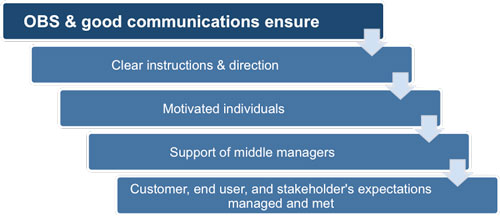
Organizational Breakdown Structure (OBS) Template
Project management relies on a formal structure that reflects the approach being adopted for managing the different facets of the project.
There are three simple steps to take when creating your project’s OBS, which will be repeated until the ‘best’ levels are identified. Firstly, depict the complete organization in a traditional hierarchy chart. Then detail all the necessary departments and teams your project requires to achieve its objective. Finally, specify the function that carries the cost of each work package and approves its sign-off.
The example below clearly shows an individual the channels or reporting and relationships and inter-dependencies between different business units or departments. The organizational structure fits its operational needs and enables it to achieve its future objectives and plans.

The organizational chart above shows that an OBS is based on functions that then splits down into the units and the individuals responsible for conducting the project work packages. This framework clearly shows the accountability within the project and who signs off each final work package and is designed for efficiency.
The OBS deals with the organizational side of the project by identifying who has the technical abilities, as well as being available at the time required in the project schedule for key deliverables. This may be an individual, a business unit or a contractor that is required to meet project deadlines.

A project with use the OBS document in conjunction with the work breakdown structure (WBS) document and the responsibility assignment matrix to ensure that every work package and project deliverable have a single business unit assigned to its production.
OBS – ensures a unit and individuals are allocated to perform each project task.
WBS – breaks down the project activities into manageable chunks using a process of decomposition. Each chunk of work is small enough to accurately cost both in terms of material and time so that it can be represented on a Gantt chart. The WBS also identifies project cost centers.
RAM – assigns who is responsible and accountable for the production of each work package. This can be a business unit as well as an individual.
Lower-level areas of the OBS where a manager can be assigned the ownership of this package allow a management control point to be identified. (Also referred to as a ‘control account’.) In the same was as WBS decomposing deliverables the OBS performs the same exercise until the project team has specific responsibilities in relation to a single organizational unit.
For example: A variety of resources need to be purchased to conduct the project therefore there must be a purchasing unit within the project organization. The relationship between OBS and WBS is to establish enough Control Accounts to ensure good planning and control discipline and visibility, but not so many that the system becomes overly cumbersome and costly to operate.
It is extremely important not to create a management control process that involves too much administration and form filling, because this will dramatically reduce the efficiency of the project. As project manager it is vital that you define the level of integration between the organizational breakdown and levels of work so that the cost and efficiency of managing the project is optimized.
This iterative process is completed once you have established sufficient control points or account to guarantee that the system for controlling, ensuring clarity and sound planning are cost effective and are not unwieldy. Control points form where a comparison can be made between actual costs versus earned value as part of project monitoring and control. Managers of a control point have the ability to authorize any re-work within the framework of their assigned budget and schedule.

In situations where it is impractical to assign these control points for the entire baselines of the project then agreement is sought from stakeholders and sponsor until such time as sufficient detail is available to complete this exercise. A project manager must reassure those involved that there are enough resources allocated to a work package or deliverable to ensure it can be accomplished as planned. This emphasizes the importance of good communications at all levels of the project.
